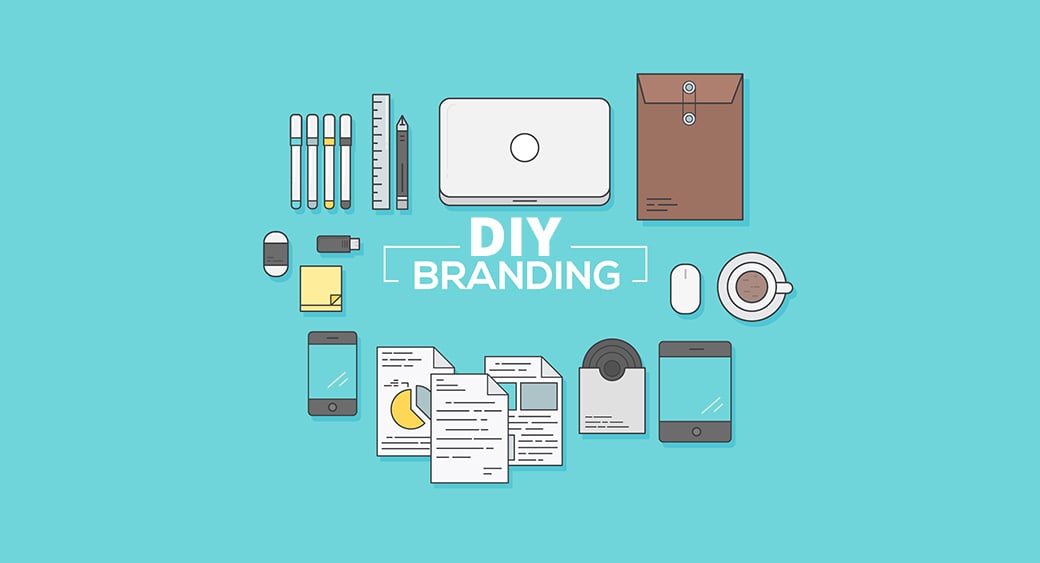DIY Branding For Small Business – Thorny Path to Brand & Company Identity
Most people believe that a brand and a business are the same things. Contrary to the popular belief, both of them are quite different from one another. A company is an organization that needs to sell its products and services to the intended audience. The brand, on the other hand, is like the cherry on top of the icing. Even if it`s DIY branding for small business, it’s the company’s personality that a brand represents. It’s equally as important as the company’s strategies that contribute to the formation of the company’s façade.

Business branding is highly important. Considering the definition of branding in this modern age, it is a process that aligns a company’s internal values and objectives with the way it interacts with its audience. For one thing, half of your brand is composed of what ideas you want to project, the other half is contributed by the customers, whose perception shapes brand appearance and efficacy.
When defining your brand identity and DIY branding for small businesses, most small businesses want to make it to the top without confronting the challenges. A successful business owner knows how and where to apply which strategy in the most appealing manner. Without wasting a second, he goes for DIY solutions and guides to make his entrepreneurship journey interesting and equally productive.
Importance Of DIY Branding For Small Business
Let’s examine why DIY branding is important for a business and how it changes how we see a brand fail or prosper.
1. Branding Offers Better Business Recognition
When a company initiates its branding process and is all set to step into the market, what matters the most is how the customers’ expectations will be met. Since we’re programmed to pick up on visual cues better than anything else, customers view the desired product after they’ve been exposed to the brand’s face, i.e., its logo.
The more simplified and unique the logo, the more will be easier for your customers to recall. Your logo design represents a major part of your product branding strategy. It gives the impression your company wishes to deliver. Pro-tip: use a free logo maker to develop a logo that already adheres to important design principles rather than taking care of that yourself.
Logo Design Basics
Your logo design must define at least one of the fundamentals or the core values of DIY branding for small businesses and huge corporations. For instance, if you’re running a bakery business, you’ll probably showcase the image of the product your company specializes in delivering, like cakes or pastries. The distinction of your company is the product of how your customers recognize your product.
However, many well-known brands use ingenious company branding techniques and strategies to capture audiences’ emotional interests and preferences. Emotions can be triggered using colors, shapes, design, and text.

Here’s another example: if you’re hit by a red car in your childhood, you’ll probably have a remote memory. And what keeps this memory alive is your constant exposure to the vehicles colored red. Similarly, brands employ the color tactic to keep their brand identity consistent and memorable.
2. Branding Encourages Consumer Trust
Apart from having their emotions triggered, the next thing the customers expect is the quality of product or service you’re providing. A brand that delivers what it promises is the one that customers like to choose. That is one of the most crucial principles of the DIY branding for small business.
A strong brand doesn’t only deliver products; it makes sure its customers are receiving the value. A logo that lies parallel to your brand’s motives imparts credibility and helps your customers decide for themselves. And when the products exceed the customers’ expectations, they go on expecting the same quality of the product, hence building a trust relationship with the brand.

The professional side of the company includes its legitimacy and polished appearance, which is preserved when the consumers feel comfortable with the brand’s name and its logo.
For instance, if you run a business in the academic field, you need to project your professionalism via your logo on your business cards, e business card, t-shirts, advertisements, relevant content, and online presence to build the trust bridge. If you’re thinking that DIY branding for small businesses can’t earn consumer trust that quickly, think again. Giving your customers a strong reason to believe your brand’s values and motives is a great way to captivate consumer trust.
3. Branding Generates Revenue
Consider a brand as a complex structure that connects your business with your world. Its growth depends on how your customers respond to the services, especially the brand’s message. A good business depends on having good merchandise, but it only generates sales when its audience is well aware of its presence.
One crucial aspect of building a professional brand image is maintaining clear and professional financial documentation. For example, using a sample invoice receipt template ensures that your transactions are well-documented, reinforcing trust and credibility with customers. When customers see organized and professional invoices, they perceive the brand as more legitimate and reliable, increasing the likelihood of repeat business.
Pick any significant business and analyze how they generated revenue in the shortest possible time. You may notice that the improvement in sales is directly related to the brand persona and its reputation among the customers.
4. Branding Enhances the Access to Your Audience
Since we discussed the referral, there are many ways via which branding can actually introduce you to a broader level of audience. Social media plays a significant role here. You can exceed the potential of your business, increase the number of target prospects via multiple folds, and increase your reach beyond the spatiotemporal context.

A brand that explores its customer database and provides relevant content on the social media platform is likely to attract the right audience. The customers become advocates of the brand, motivated by the zeal to propagate the practical results achieved with this product. DIY branding for small businesses is a great way to captivate the audience that resonates with your company’s personal values.
Moreover, using social media for business isn’t an option anymore; it has become more of a choice which builds brand awareness. Your customers share the notion of familiarity and loyalty to you and associate your brand image with company values. They tend to prefer your brand over your competitors.
5. Branding Creates New Marketing Opportunities
There is no brand on earth that can survive the market heat without having some marketing strategies to cover them up. Marketing is severely vital for your company branding.
Just think for a while; without proper channels to communicate your company values, your brand will stagnate and become inflexible when handling market pressure. Alternately, if you are aware of the consumer market demands and your product aligns with them, marketing is going to open new doors for you. From traditional to digital marketing techniques, businesses have comprehensive options to pursue.
Once you label your business with a brand, there are high chances that you’ll be expanding your services in the near future. A successful marketing campaign enables progressive product branding, which lets you reach other options for benefitting your company and customers.
Consider the example of Coca-Cola. People love this brand because the product has maintained a consistent standard of quality as well as a marketing approach that has created opportunities for business branding. Cases as such make great lessons for startups and established companies.
DIY Ways To Brand Your Business
DIY branding for small businesses is a big task. Before you start the branding process, you must first make up your mind about the services you’re going to offer and how those differentiate you from others in the market.
1. Define What Your Brand Means for Your Business
You must keep in mind that branding is a way to enhance your presence and give your company definite recognition. Ask yourself the following questions to see if you’re clear on how well you’re defining your company.
- What is my company about?
- What are my personal values?
- Do my values reciprocate the company’s goals?
- Who is my target audience?
- What makes my business different?
- Who are my competitors?
- What are my company’s strengths and weaknesses?
- What sort of challenges does the industry present?
- Which strategies will prove more effective?
- How will my brand contribute to customer experience?
Contemplating questions like these enables you to analyze what’s happening around the brand you’ll be constructing. It might seem too early to answer most of these questions since you experience every twist and turn in time, but mulling over them could deliver you a competitive analysis.
Goals and Core Values of Your Business Branding
Once you’ve determined what your business is founded on and how it would operate under the brand name, you’ll be exploring the objectives and goals of your business. It’s always a good idea to connect your overarching aims with the core values of your business.

This initial stage of business branding costs you – not in financial terms, but in terms of time. Be sure to give the brand idea ample time and consideration because your business will depend on branding and vice versa once the process has begun.
If you’re a small business that needs guidance and help, the Small Business Administration provides ultimate guidance on planning, launching, managing, and growing your business. You can also avail business counseling and loans in order to execute your branding strategy.
2. Construct a Clear Brand Mission Statement
A line or two sums up your whole company is a brand mission statement. You have to brainstorm for ideas to jot down this one sentence that is concise in what it means.
Your mission statement should adhere to the overall structure of your branding strategies. Every brand has a story to tell, and the mission statement delineates what your company does. This message is specified to the company’s internal functions, ideology, the reason for being, its prospects in the market, and the competitive advantage it has over its competitors. And it’s the only way for the DIY branding for small businesses to make a lasting impact.
Role of the Statements
These statements are mostly delivered to inspire and motivate the company’s employees. Though the timely objectives might demand different actions and products from the company, the mission statement remains the same.
If you want to write a mission statement, just use the words that describe your company. Form a proper sentence. It’s up to you to use a word or a sentence. Once you take it slow and steady at a time, you can elaborate on your mission statement. Ensure that your mission statement resonates with your long-term goals and is flexible.
If you have ever noticed, giants in every industry started off by constructing their mission statement in the simplest manner, using simple and easy words anyone can understand. Check out what Coca-Cola has for a mission statement:
“To refresh the world in mind, body, and spirit. To inspire moments of optimism and happiness through our brands and actions.”
See what they did there? With a brand message, they’ve pointed out the values they are willing to deliver to their audience. Now, observe how successful their product branding is. Their mission aligns with their marketing strategies.
3. Determine Your Target Audience
Albeit other parts are essential, pinpointing your target audience is the cornerstone of branding. Your business runs because of your customers, the driving force behind your brand. Imagine that you’re pitching for an apparel line and have a generalized audience in mind. In theory, you can generate a lot of revenue with a vast audience, but the risks are more than the prospects. The audience is pretty extensive, and you’re unable to gather data on the wide range of customers you’re opting to serve.
There are improbable chances that you’ll cater perfectly to every type of customer. For people starting DIY branding for small businesses, selecting a cohort of the audience towards whom your product is directed is crucial. Based on your customers’ preferences, you can create a virtual consumer profile and collect data based on how your brand is performing in the market. As your customer database keeps growing, you can analyze it and devise marketing strategies that favor your company’s success. Make sure you deliver the value that your customers prize. Always prioritize your customer’s needs and create a call to action to trigger their affirmative responses.
4. Research The Market
Market research is the key to building effective and foolproof strategies. It enables you to take an in-depth review of what going around in the market atmosphere. The data and information regarding the activities of your competitors. The main focus of it all shouldn’t be to exceed your competition only, it’s also about captivating potential customers. But instead of opening too many tabs in your head, try using Google Trends, and other resources, such as SpyFu and Dun & Bradstreet, to learn details about the competitor’s choice of keywords and customer behavior on their sites.

Now, there are also other keyword research tools you can use to evaluate who your competitors are and what makes their company branding so effective. Make sure you check out other resources, such as Alexa, Keyword Spy, and Compete to name a few.
Though these tools are a great way to analyze the competitive market, social media leads to the way into blowing anyone’s trumpet – and that could be your competitor too. Once you run the analysis and memorize how your competitors roll in the market, it’s time to use popular social media platforms like Facebook, Twitter, Snapchat, and LinkedIn to keep a bird’s eye view on their customer-attracting tactics.
Ask their customers, read blogs, or conduct online surveys to keep updating yourself. You can also think about merging consumer data with your market analysis to narrow down the approach towards gaining a competitive edge in the market.
5. Align Business Goals With Personal Values
DIY branding for small businesses isn’t complete without you having to plan out your views in congruence with the values you want to showcase via your brand image. Your customers just don’t want to buy your product, they want to bridge the consumer-brand gap as much as you want to.
And in one of those moments, the customers like to reach beyond the brand façade and want to connect on a personal level and share their values. When you add value to your brand, people notice the distinction. Values define what your company believes in and help to accomplish long-term goals and make loyal customers. When your company fails to communicate its value, you are likely to be labeled with identity theft.
In case you’re confusing brand values with brand image, just know that these values are the principles that guide you throughout your brand strategy. It is the driving force behind your ideas, motives, intentions, actions, behaviors, and decisions.
Role of the Values
A set of values distinct to your company character attracts customers, influences their shopping decisions and enhance the customer experience to a greater extent. And that, in turn, affects your sales because the more your values align with your company, the more trustworthy your customers will consider you. You can converge your values to strengthen the core of your business. Some businesses just lay out small objectives and define their core values until the task is completed. Employing different values for short-term leaves the business in utter turmoil due to their ever-changing personal values.
A case of this pushes the brand identity vague and unreliable. On the other hand, successful brands select their values and infuse them for long-term. These values are observed from the top to the bottom level of the organization and instantly become the company’s code of conduct and its standard that guides the company in the right direction.
6. Create An Appealing Brand Identity
Once the process of defining your brand and determining the core values is finalized, the pinnacle of branding your business comes. It’s the logo that allows the customers to recognize you. Sure, the name could gain you some recognition, but then again, a powerful logo can shape the customer perception beyond your wildest imagination. The colors, the context, and the design… every bit of the logo has a distinct language that combines with other elements to eliminate the brand-logo alienism. However, there are specific rules for a logo design. A good and universal logo is the one that is relevant, simple, modern, memorable, scalable, timeless, and evergreen.
As for selecting the color, it has a psychology of its own. Unless it fits the logo design guidelines, you can choose your color palette from the hottest color trends. With colors deciphering your brand voice, your logo must make a strong and lasting impact. Several ways are available to have your logo designed, but the point is to get the best. You can’t possibly spend time and money discovering each and every possibility. So it’s better to be careful with what you choose.

There are several designers who can deliver you great designs, but the costs can exceed your budget. One of the best possible ways to add charm to your DIY branding for small business is to refer to an online logo maker which is not only an inexpensive option but also a great option for getting high-quality professional designs. With an automated logo maker, you can customize the logo design the way you want and can receive the options to alter the original design into something straight from your imagination. Test the colors, the font, the layouts, the shapes until you reach the point of satisfaction.
7. Deliver Exceptional Content
To deliver the content that adds value to your product branding, you must think big. Your business cognition should be independent of the worries of a tight budget, lack of resources, and the constraints of a small business mindset. And what goes through your head is defined by what type of content you’re delivering.
Sure, you can promote yourself on your website (who doesn’t?!). You just need to have a few storytelling tricks up your sleeve. There is no need to just sell your services, you also have to market your content. You have to shift towards digital marketing to adapt to the trends and strategies that are currently employed.
To sell something, make sure you’re coming clear on what type of product you deliver and how it’s going to affect the customer’s life. Take your cue from the bigger brands. They’re loaded with stellar stories that make the customer more familiar with the brand.
To get things right, scour your customer database and see what your customers prefer and how you can deliver an exceptional experience beyond their expectations. Motivate ‘your people’ to become part of your brand by taking a poll or a quiz on your website or your brand’s social media page. And in case of DIY branding for small business, content marketing strategies – when paralleled with digital media – improve your chances of getting noticed.
Moreover, don’t forget to optimize the content you deliver. Buy the keywords that are suitable for your business and improve your SEO strategies to remain ahead of your game.
8. Accept Failure
Failure comes in all shapes and sizes and there’s no escape from it. Apart from being motivated about building your brand identity, you have to accept the risks that come attached to each opportunity. Rising on top of the competition isn’t something easy. It could be that you’re focusing too much on the logo design that you forget to improve your customer service or vice versa.
The mistakes and failures are a way to evolve continuously without losing the motivation to keep going. Even if you own a small business in a boring marketplace, you have to conjure up that appeal to your brand personality. Talk to your customers about what they like and dislike and tighten up the loose ends on your side. It’s the only way to learn and evolve.
DIY Branding for Small Business – Final Words
Running a business and constructing it from scratch takes strenuous effort. Your brand is the platform where you stand and showcase a sleek business and mark the success of it. If you’re one of those aspiring entrepreneurs who want to take the lead and come with their DIY branding for small business, make sure you keep yourself alert on whatever is happening around you and where you need to invest.
Be patient if it takes time. It’s going to become a big one someday.




Leave a Reply